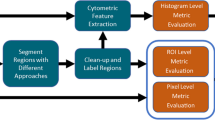Abstract
In this paper, we propose variants of deep learning methods to segment head and operculum of the zebrafish larvae in microscopy images. In the first approach, we used a three-class model to jointly segment head and operculum area of zebrafish larvae from background. In the second, two-step, approach, we first trained binary segmentation model to segment head area from the background followed by another binary model to segment the operculum area within cropped head area thereby minimizing the class imbalance problem. Both of our approaches use a modified, simpler, U-Net architecture, and we also evaluate different loss functions to tackle the class imbalance problem. We systematically compare all these variants using various performance metrics. Data and open-source code are available at https://uliege.cytomine.org.
Access this chapter
Tax calculation will be finalised at checkout
Purchases are for personal use only
Similar content being viewed by others
References
Cassar, S., et al.: Use of zebrafish in drug discovery toxicology. Chem. Res. Toxicol. 33(1), 95–118 (2019)
Chollet, F., et al.: Keras (2015). https://github.com/fchollet/keras
Evans, J.G., Matsudaira, P.: Linking microscopy and high content screening in large-scale biomedical research. High Content Screen. 33–38 (2007)
Guan, H., Liu, M.: Domain adaptation for medical image analysis: a survey. arXiv:2102.09508 (2021)
Hill, A.J., Teraoka, H., Heideman, W., Peterson, R.E.: Zebrafish as a model vertebrate for investigating chemical toxicity. Toxicol. Sci. 86(1), 6–19 (2005)
Kingma, D.P., Ba, J.: Adam: a method for stochastic optimization. arXiv:1412.6980 (2014)
Lessman, C.A.: The developing zebrafish (danio rerio): a vertebrate model for high-throughput screening of chemical libraries. Birth Defects Res. C Embryo Today 93(3), 268–280 (2011)
Ma, J., et al.: Loss odyssey in medical image segmentation. Med. Image Anal. 71, 102035 (2021)
Marée, R., et al.: Collaborative analysis of multi-gigapixel imaging data using cytomine. Bioinformatics 32(9), 1395–1401 (2016)
Mikut, R., et al.: Automated processing of zebrafish imaging data: a survey. Zebrafish 10(3), 401–421 (2013)
Ronneberger, O., Fischer, P., Brox, T.: U-Net: convolutional networks for biomedical image segmentation. In: Navab, N., Hornegger, J., Wells, W.M., Frangi, A.F. (eds.) MICCAI 2015. LNCS, vol. 9351, pp. 234–241. Springer, Cham (2015). https://doi.org/10.1007/978-3-319-24574-4_28
Tarasco, M., Laizé, V., Cardeira, J., Cancela, M.L., Gavaia, P.J.: The zebrafish operculum: a powerful system to assess osteogenic bioactivities of molecules with pharmacological and toxicological relevance. Comp. Biochem. Physiol. Part C: Toxicol. Pharmacol. 197, 45–52 (2017)
Acknowledgments
This work, as well as N.K. and A. C. are supported by the EU MSCA-ITN project BioMedAqu (766347). R.M. was partially supported by ADRIC Wallonia Grant and EU IMI BIGPICTURE grant. M.M. is a “Maître de Recherche” at the Fund for Scientific Research (F.R.S.–FNRS).
Author information
Authors and Affiliations
Corresponding author
Editor information
Editors and Affiliations
Rights and permissions
Copyright information
© 2021 Springer Nature Switzerland AG
About this paper
Cite this paper
Kumar, N. et al. (2021). Deep Learning Approaches for Head and Operculum Segmentation in Zebrafish Microscopy Images. In: Tsapatsoulis, N., Panayides, A., Theocharides, T., Lanitis, A., Pattichis, C., Vento, M. (eds) Computer Analysis of Images and Patterns. CAIP 2021. Lecture Notes in Computer Science(), vol 13052. Springer, Cham. https://doi.org/10.1007/978-3-030-89128-2_15
Download citation
DOI: https://doi.org/10.1007/978-3-030-89128-2_15
Published:
Publisher Name: Springer, Cham
Print ISBN: 978-3-030-89127-5
Online ISBN: 978-3-030-89128-2
eBook Packages: Computer ScienceComputer Science (R0)




